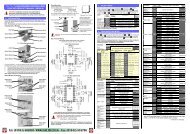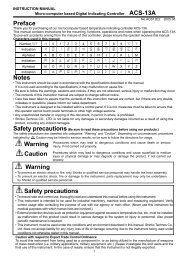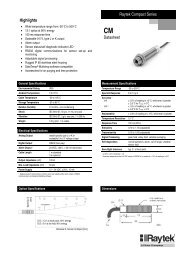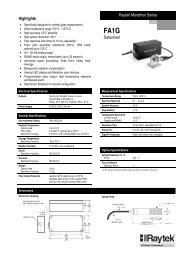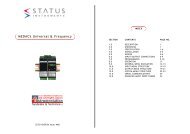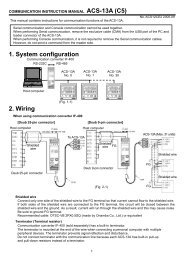to download the Eurotherm piccolo⢠Manual in PDF format
to download the Eurotherm piccolo⢠Manual in PDF format
to download the Eurotherm piccolo⢠Manual in PDF format
Create successful ePaper yourself
Turn your PDF publications into a flip-book with our unique Google optimized e-Paper software.
User <strong>Manual</strong><br />
Piccolo Range<br />
4.5 Alarms Advanced<br />
4.5.1 Behaviour of Alarms after a Power Cycle<br />
The response of an alarm after a power cycle depends upon <strong>the</strong> latch<strong>in</strong>g type, whe<strong>the</strong>r it has been configured <strong>to</strong> be<br />
a block<strong>in</strong>g alarm, <strong>the</strong> state of <strong>the</strong> alarm and <strong>the</strong> acknowledge status of <strong>the</strong> alarm.<br />
The response of active alarms after a power cycle is as follows:<br />
For a non-latch<strong>in</strong>g alarm, block<strong>in</strong>g, if configured, will be re-<strong>in</strong>stated. If block<strong>in</strong>g is not configured <strong>the</strong> active alarm<br />
will rema<strong>in</strong> active. If <strong>the</strong> alarm condition has gone safe dur<strong>in</strong>g <strong>the</strong> down time <strong>the</strong> alarm will return <strong>in</strong>active.<br />
For an au<strong>to</strong>-latch<strong>in</strong>g alarm, block<strong>in</strong>g, if configured, will be re-<strong>in</strong>stated, only if <strong>the</strong> alarm had been acknowledged<br />
prior <strong>to</strong> <strong>the</strong> power cycle. If block<strong>in</strong>g is not configured or <strong>the</strong> alarm had not been acknowledged <strong>the</strong> active alarm will<br />
rema<strong>in</strong> active. If <strong>the</strong> alarm condition has gone safe dur<strong>in</strong>g <strong>the</strong> downtime <strong>the</strong> alarm will return <strong>in</strong>active if it had been<br />
acknowledged prior <strong>to</strong> <strong>the</strong> power cycle else it will return safe but not acknowledged. If <strong>the</strong> alarm was safe but not<br />
acknowledged prior <strong>to</strong> <strong>the</strong> power cycle <strong>the</strong> alarm will return safe but not acknowledged.<br />
For a manual-latch<strong>in</strong>g alarm, block<strong>in</strong>g will not be re-<strong>in</strong>stated and <strong>the</strong> active alarm will rema<strong>in</strong> active. If <strong>the</strong> alarm<br />
condition has gone safe dur<strong>in</strong>g <strong>the</strong> downtime <strong>the</strong> alarm will return safe but not acknowledged. If <strong>the</strong> alarm was safe<br />
but not acknowledged prior <strong>to</strong> <strong>the</strong> power cycle <strong>the</strong> alarm will return safe but not acknowledged.<br />
The follow<strong>in</strong>g examples show graphically <strong>the</strong> behaviour under different conditions:-<br />
4.5.2 Example 1<br />
Alarm configured as Low; Block<strong>in</strong>g: No Latch<strong>in</strong>g<br />
Alarm<br />
SP<br />
PV<br />
Power<br />
on<br />
Power<br />
off/on<br />
Power<br />
off/on<br />
4.5.4 Example 3<br />
Alarm configured as Low; Block<strong>in</strong>g: Au<strong>to</strong> Latch<strong>in</strong>g<br />
PV<br />
Power<br />
on<br />
Ack<br />
1<br />
Power<br />
off/on<br />
Ack<br />
2<br />
Power<br />
off/on<br />
Ack<br />
3<br />
Ack<br />
4<br />
Alarm<br />
SP<br />
Alarm<br />
ON<br />
Alarm<br />
OFF<br />
4.5.3 Example 2<br />
Alarm configured as Low; Block<strong>in</strong>g; <strong>Manual</strong> Latch<strong>in</strong>g<br />
PV<br />
Power<br />
on<br />
Power<br />
off/on<br />
Power<br />
off/on<br />
Ack Ack Ack Ack<br />
Alarm<br />
ON<br />
Alarm<br />
OFF<br />
Ack 2 - alarm<br />
output rema<strong>in</strong>s<br />
<strong>in</strong> alarm<br />
condition but<br />
ALM <strong>in</strong>dication<br />
goes steady<br />
Alarm<br />
SP<br />
Alarm<br />
ON<br />
Alarm<br />
OFF<br />
Note: The alarm will only cancel when <strong>the</strong><br />
alarm condition is no longer current AND<br />
<strong>the</strong>n it is acknowledged<br />
Alarm<br />
ON<br />
Alarm<br />
OFF<br />
Ack 3 - alarm output<br />
rema<strong>in</strong>s active until <strong>the</strong><br />
condition caus<strong>in</strong>g <strong>the</strong><br />
alarm disappears<br />
Ack 4 - alarm output<br />
rema<strong>in</strong>s active until<br />
acknowledged<br />
30 Part No HA031260 Issue 1 May -12




